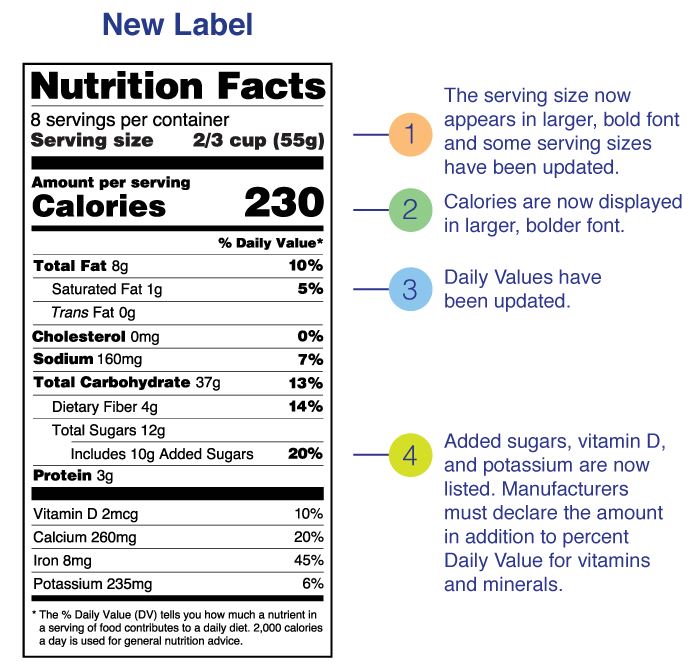This year, the Food and Drug Administration (FDA) unveiled a new Nutrition Facts label on packaged foods and beverages. They issued the release in March, but with the national attention focused on coronavirus shutdowns, it may have gotten lost in all the other the news. It’s worth taking note – the FDA says this was the first major update in more than 20 years. They made the changes to make it easier for consumers to read and to provide key information that will allow consumers to make informed choices. The changes are based on updated scientific information, new nutrition research, and input from the public. It began appearing on some food items at the beginning of the year and all manufacturers have until July 2021 to comply.

Four key elements of the new Nutrition Facts label have been changed: serving size, calories, Daily Values, and nutrients.
Serving Size – updated to better reflect the amount people typically eat and drink today. NOTE: The serving size is not a recommendation of how much to eat. Learn more about serving sizes on the new Nutrition Facts label.
Calories – now in larger and bolder font to make the information easier to find and use. 2,000 calories a day is used as a guide for general nutrition advice. Your calorie needs may be higher or lower depending on your age, sex, height, weight, and physical activity level. Check your calorie needs.
Learn more about calories on the new Nutrition Facts label.
Percent Daily Value – the percent Daily Value (%DV) shows how much a nutrient in a serving of food contributes to a total daily diet. Daily Values for nutrients have been updated, which may make the percent higher or lower on the new Nutrition Facts label. As a general guide: 5% DV or less of a nutrient per serving is considered low; 20% DV or more of a nutrient per serving is considered high.
Learn more about updated Daily Values on the new Nutrition Facts label.
Nutrients – Vitamins A and C were removed because deficiencies are rare. Calories from fat was removed because the type of fat consumed is more important than the amount. Vitamin D and potassium are now required to be listed on the label because Americans do not always get the recommended amounts. Added sugars are also new to provide information about processed sugars in the foods. Vitamin D and potassium are now required. Calcium and iron will continue to be listed.
Learn more about added sugars on the new label.
Need more help with nutrition & diet? ESI EAP can help!
Did you know that ESI EAP has Wellness Coaching for nutrition, weight loss, stress, and more? Wellness Coaching includes one-on-one coaching and counseling from an integrated team of coaches and clinicians. Employees engaging with a Wellness Coach improve their health and ultimately reduce health care costs. Almost two-thirds of our Members who engage with a Coach ultimately reach their wellness goals. We also offer an online self-help Wellness Resource Center, featuring the latest, most reliable articles, trainings, videos, and self-assessments for dealing with stress, diet, fitness and smoking. Plus, be sure to check out more from our Wellness Blog.

